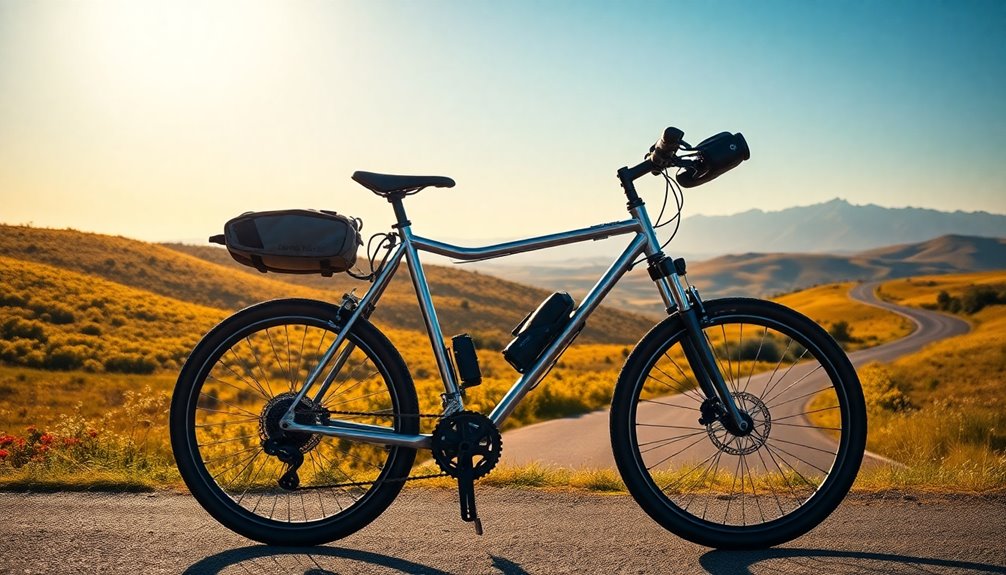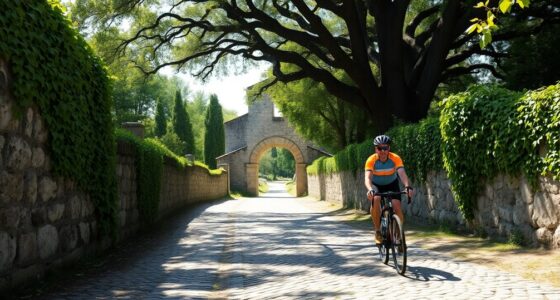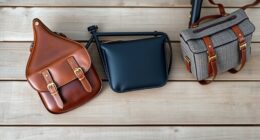Choosing the right bike for touring adventures depends on your terrain and riding style. For smooth paved roads, a touring or gravel bike works well. If you prefer rough trails, consider a bikepacking or hybrid bike. Look for durable materials like steel for longevity and comfort. Ensure it has good braking systems and safety features for added protection. Don't forget essential accessories to enhance your trip. There's more to explore about gearing and customization options too!
Key Takeaways
- Determine your terrain: Choose a bike suited for paved roads, rail trails, dirt roads, or multi-use trails based on your intended routes.
- Select the right bike category: Consider touring, bikepacking, gravel, eBikes, or hybrid bikes depending on your travel style and road conditions.
- Evaluate frame material: Opt for steel for durability and comfort, or aluminum for lightweight options, balancing cost and longevity.
- Prioritize braking and safety features: Look for bikes with disc brakes for better stopping power and invest in visibility gear for safety.
- Set a budget: Aim for touring bikes between $600 to $1,300, including essential gear and potential upgrade costs in your overall budget.
Understanding Your Touring Terrain
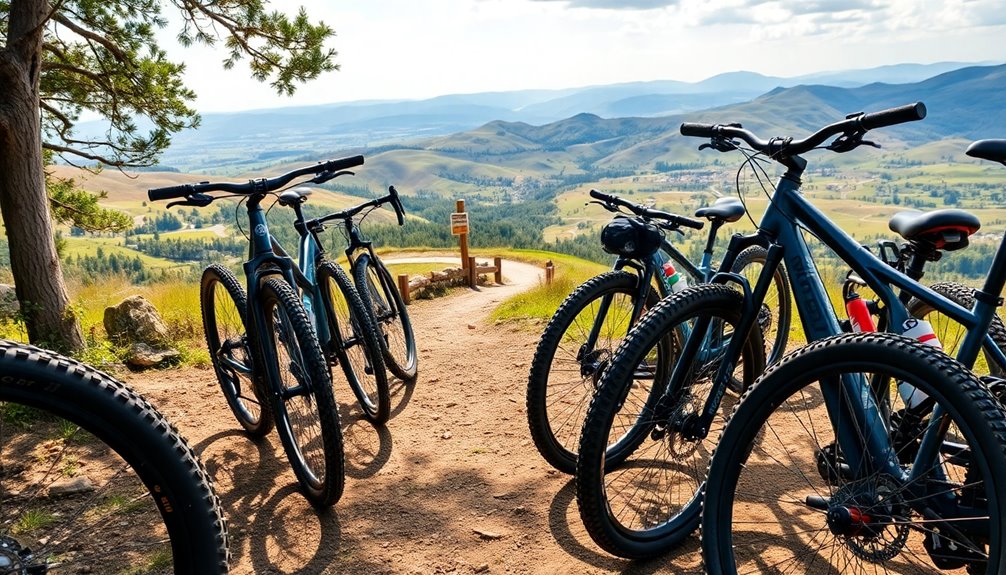
When planning your bike tour, understanding the different types of terrain you'll encounter is essential for a successful experience.
You'll find paved roads offer smooth rides but require caution due to shared traffic. Rail trails are perfect for beginners, providing safe, low-gradient paths.
Dirt roads can be a mixed bag, ranging from well-maintained routes to rough trails that demand technical skills. Multi-use trails combine various surfaces, allowing for diverse cycling experiences.
Prioritize routes with low traffic and wide shoulders for safety. Remember that weather conditions can impact terrain difficulty, and the right tire selection is crucial.
Educate yourself on each terrain's unique challenges to ensure a safer, more enjoyable adventure.
Selecting the Right Bike Category
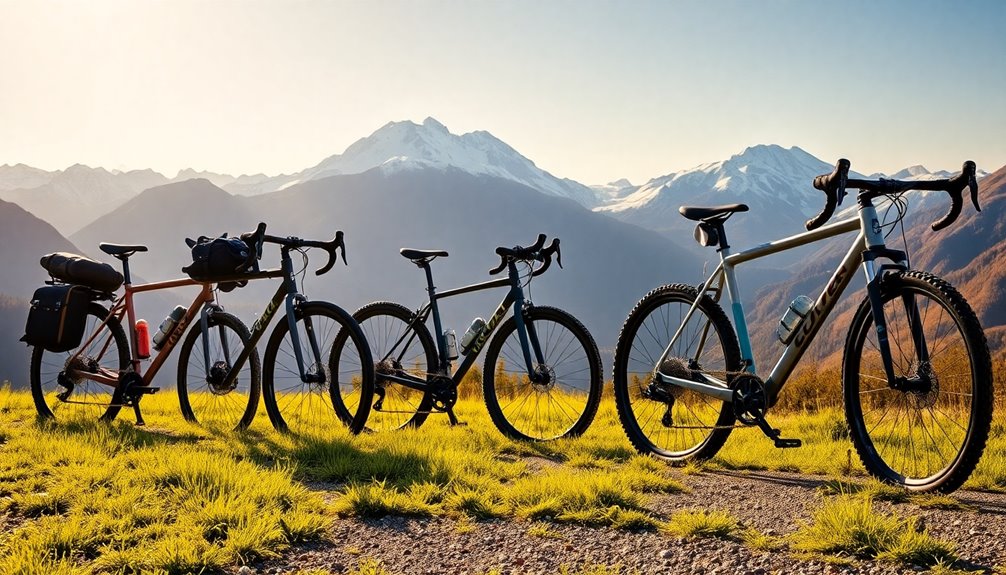
How do you choose the right bike category for your touring adventure? Start by considering your journey's terrain and style.
If you're planning long-distance travel, a touring bike with a steel frame, drop bars, and wide-range gearing is ideal.
For off-road trails, a bikepacking bike with large tires and low gearing will perform best.
Gravel bikes are perfect for mixed terrains, as they handle both paved and unpaved roads comfortably.
If you need extra support, an eBike can make your ride easier.
Lastly, specialty bikes like recumbents or folding bikes offer unique experiences. Additionally, hybrid bikes provide versatility on various terrains, making them a great option for diverse cycling adventures.
Evaluating Frame Material and Durability
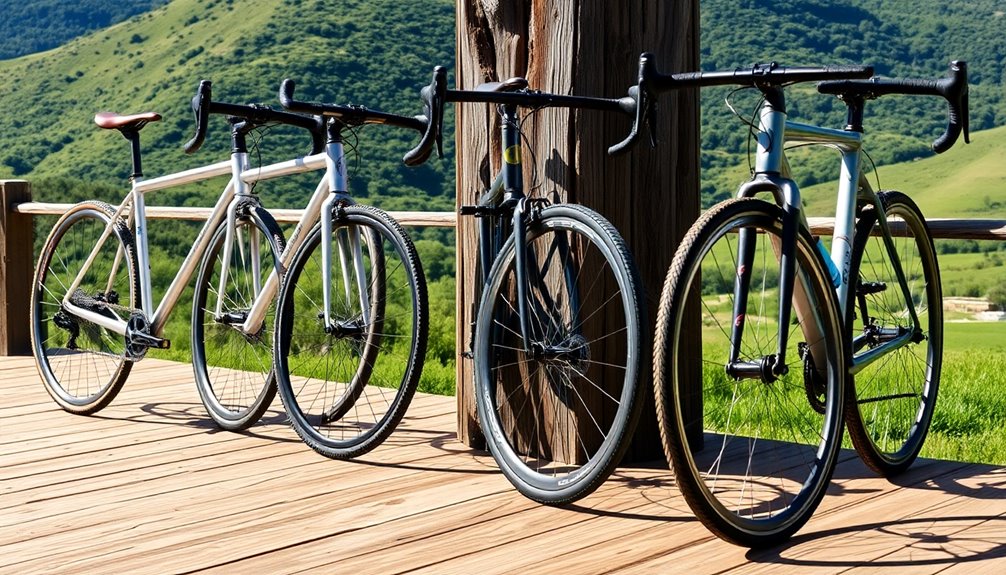
Choosing the right frame material is crucial for ensuring your touring bike meets the demands of your journey.
Aluminium frames are lightweight and affordable but can fatigue over time, making them less comfortable.
Steel frames offer strength and durability, absorbing road vibrations well, though they're heavier and need rust protection.
Titanium frames combine lightweight and corrosion resistance, but they come at a high price.
Carbon frames are stiff and light but less durable than metal.
When evaluating frame durability, steel and titanium bend rather than break, providing a safety buffer.
Consider repairability too, as steel frames are easier to fix.
Ultimately, your choice should balance weight, comfort, and longevity based on your touring needs.
Importance of Braking and Safety Features
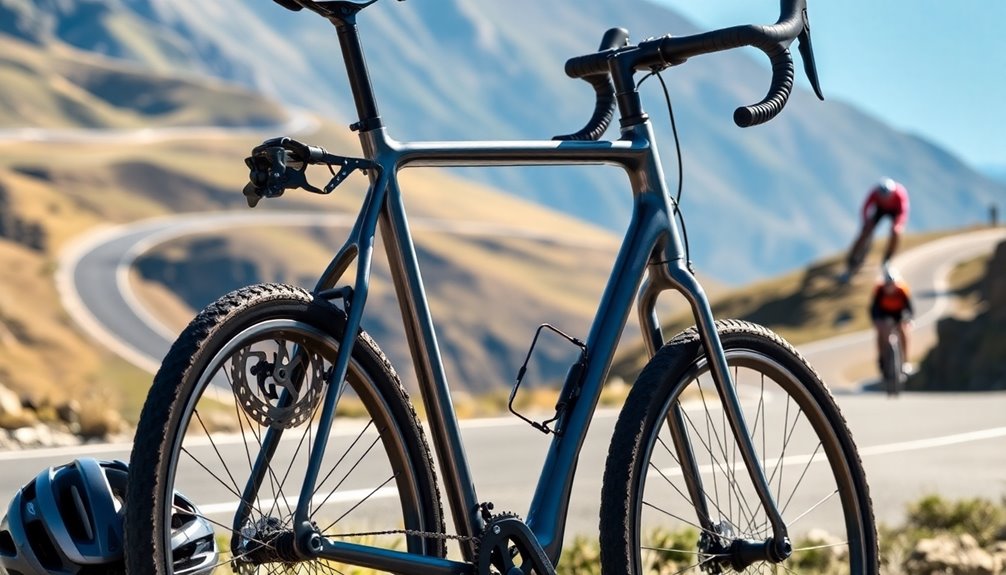
While biking through varied terrains, understanding the importance of braking and safety features can significantly enhance your touring experience.
Opt for disc brakes for superior stopping power, especially in wet conditions; hydraulic systems offer smoother operation. Regular brake maintenance is vital to ensure optimal performance, so don't skip those checks.
For safety, wear high-visibility clothing and use reflective gear to increase your visibility. Equip your bike with headlights and flashing rear lights to alert others, especially in low-light conditions.
Always wear a helmet and consider carrying eye protection and a first aid kit. Lastly, obey traffic laws and use hand signals to communicate with other road users. Additionally, consider using a basic toolkit for emergency repairs during your adventures.
Prioritizing these features will keep you safe and enhance your overall biking adventure.
Choosing the Right Gearing and Shifting System
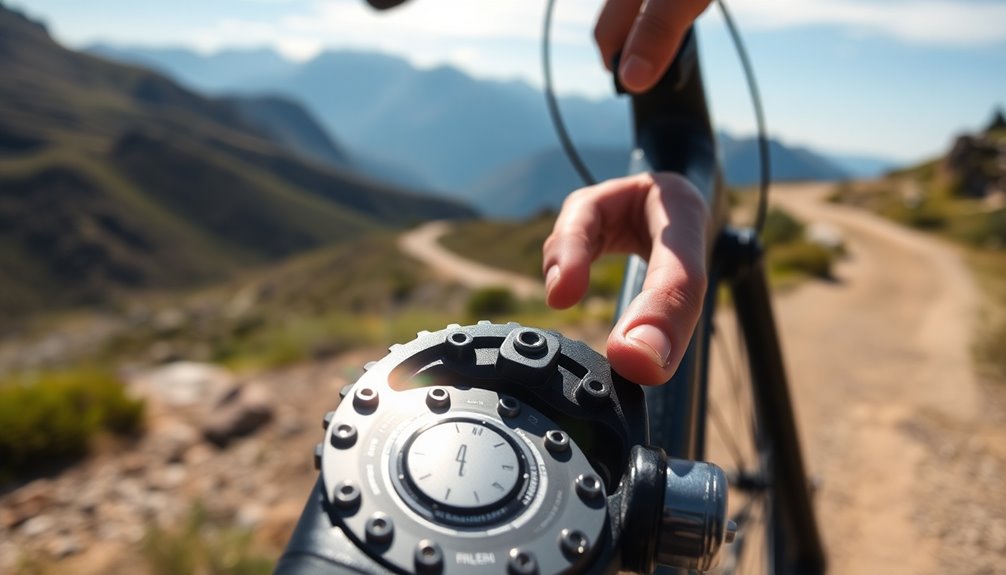
A safe and enjoyable touring experience hinges not only on effective braking but also on the right gearing and shifting system for your bike.
Aim for a gear range of at least 500% to tackle diverse terrains, ensuring your lowest gear is at or below 20 gear inches for easy hill climbing with luggage.
Consider mountain bike components for durability and adaptability. You'll want to choose between derailleur systems for versatility or hub gear systems for low maintenance.
Brifters can simplify your shifting, combining it with braking.
Customize your gearing by adjusting chainrings and cassettes based on terrain and load.
Regular maintenance will keep everything running smoothly, allowing you to focus on the adventure ahead.
Prioritizing Comfort and Ergonomics
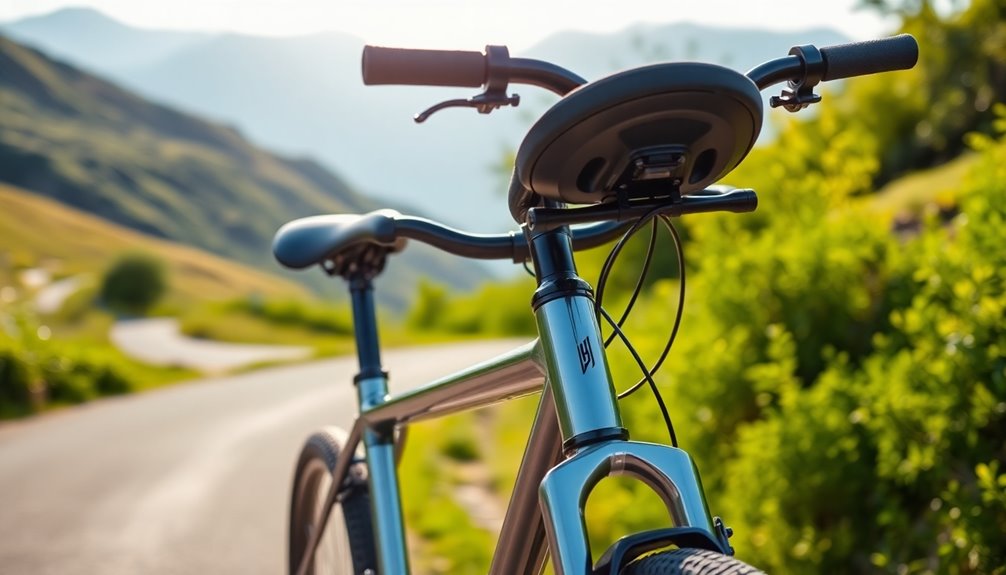
Comfort is essential for an enjoyable touring experience, and prioritizing ergonomics can make all the difference during long rides.
Start by adjusting your saddle height to prevent knee strain and back pain. Ensure your handlebars are positioned for a comfortable reach, which minimizes shoulder and neck strain. Pay attention to pedal placement, as proper positioning enhances power transfer and reduces joint stress.
A well-designed saddle that supports your anatomy is crucial for long-term comfort. Additionally, choose a bike with relaxed frame geometry, durable components, and simple gearing for ease of use.
Incorporate grip tape on handlebars and consider drop bars for multiple hand positions, helping you maintain a balanced posture and enjoy your ride to the fullest.
Essential Accessories for Touring
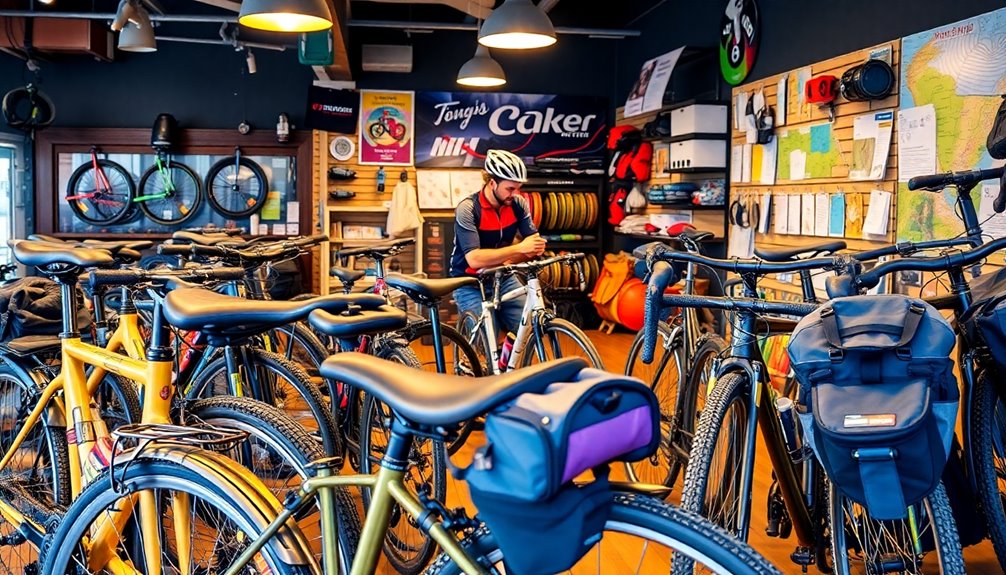
When planning your touring adventure, having the right accessories can significantly enhance your experience on the road.
Start with a reliable bike helmet for safety, and consider panniers to carry your gear efficiently.
Don't forget a headlight and taillight for visibility at night, along with a sturdy bike lock to secure your bike when you stop.
Adding a mirror enhances your safety by allowing you to see behind you. Equip yourself with spare brake pads and reflectors for low-light conditions.
For navigation, a smartphone or GPS device is essential, and a basic first-aid kit is crucial for emergencies.
Keep hydrated with a water bottle or hydration pack, ensuring you're ready for any adventure that comes your way!
Customization Options for Your Bike
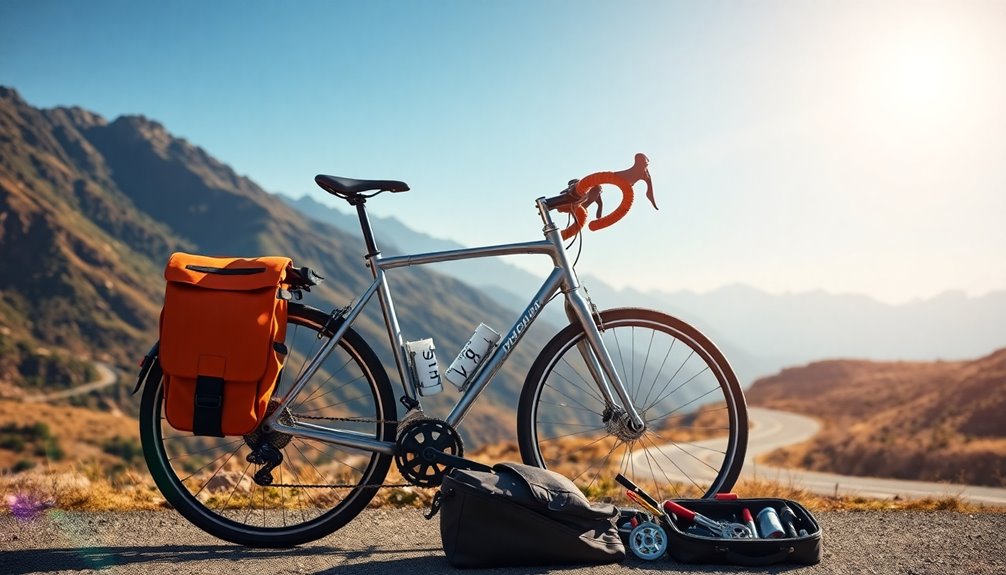
Having the right accessories can elevate your touring experience, but customizing your bike can take it to the next level.
Start with comfort: adjustable handlebars and ergonomic seats make long rides enjoyable. Consider adding front and rear suspension for smooth handling on various terrains. Enhance your ride with custom grips, footpegs, and integrated cooling systems to keep you comfortable.
For performance, opt for custom engine tuning, high-performance air filters, and brake upgrades to boost power and safety.
Aesthetic touches like custom paint, LED lighting, and unique wheels let you express your style.
Finally, think about electronic upgrades like GPS and safety lights for navigation and visibility. Each customization enhances not just your bike but your entire touring adventure.
Budgeting for Your Touring Bike and Gear
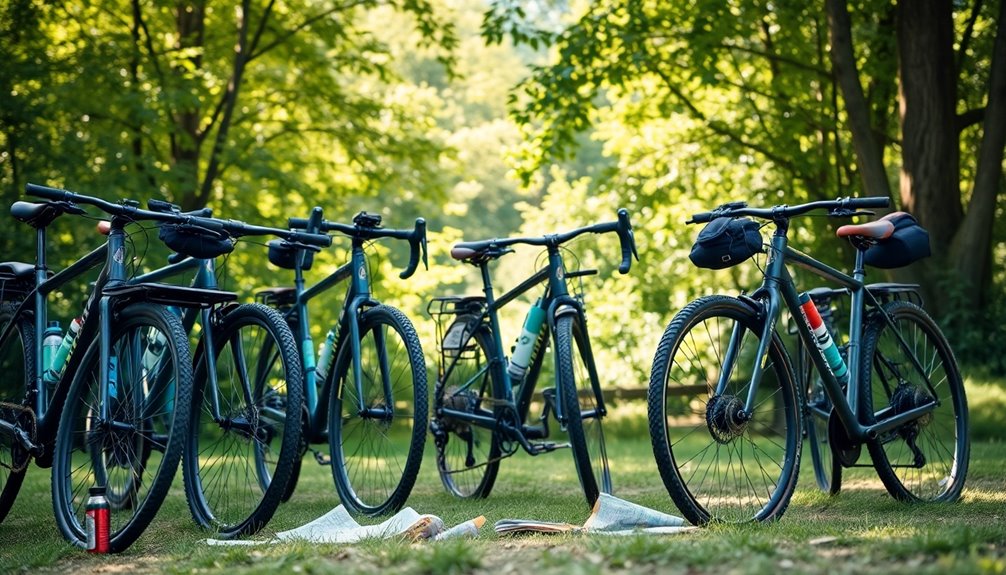
Budgeting for your touring bike and gear is essential to ensure you have a smooth and enjoyable experience on the road.
Start by considering your initial investment; budget touring bikes typically range from $600 to $1,300. Opting for a used bike can save you money while still providing a solid frame, preferably steel for durability.
Don't forget to budget for essential gear like panniers, camping equipment, and safety accessories. Repurposing backpacking gear can further cut costs.
As you plan, include funds for potential upgrades and repairs, focusing on quality components like tires and brakes.
Finally, factor in miscellaneous costs such as transportation, food, and emergency funds to cover unexpected expenses.
Frequently Asked Questions
How Do I Determine the Right Bike Size for Touring?
To determine the right bike size for touring, start by measuring your inseam and using it to estimate frame size.
Test ride various bikes to find the most comfortable fit, ensuring at least 2cm of clearance between you and the top tube.
Pay attention to the top tube length and handlebar height adjustments, as these affect your riding position.
Don't forget to consider your load-carrying needs when finalizing your decision.
What Type of Clothing Is Best for Long-Distance Biking?
When you're out on the open road, the right clothing can feel like a warm embrace against nature's whims.
For long-distance biking, prioritize comfort and adaptability. Layer up with breathable jerseys, moisture-wicking shorts, and lightweight thermal tops for colder days.
Don't forget waterproof gear for sudden showers and sun protection for those blazing afternoons.
Invest in quality gloves, socks, and a good helmet to keep you safe and comfortable throughout your journey.
How Can I Maintain My Bike While on Tour?
To maintain your bike while on tour, regularly check the chain, tire pressure, and brake pads.
Lubricate the chain every other day, and inspect cables for wear. Clean your bike to prevent dirt buildup, especially on moving parts.
Carry a multitool and spares like inner tubes and brake pads for emergencies.
Don't forget to tighten rack bolts and check the headset periodically to ensure a smooth and safe ride.
What Should I Pack for a Multi-Day Bike Tour?
Packing for a multi-day bike tour is like assembling a toolkit for adventure.
You'll need waterproof panniers to keep your gear dry, a mini bike pump for quick tire fixes, and a patch kit for emergencies.
Don't forget spare inner tubes and synthetic lubricant for smooth rides.
For comfort, pack bike shorts, jerseys, and waterproof socks.
And always bring a first aid kit, a helmet, and navigation tools to ensure a safe journey.
How Do I Choose the Right Tires for My Touring Bike?
When choosing the right tires for your touring bike, consider the diameter and width that best suit your needs.
Wider tires offer comfort for long rides, while the tread pattern should match the terrain you'll encounter.
Ensure there's enough clearance between the tires and the frame.
Opt for durable materials that can handle your load, and look for options that reduce rolling resistance for enhanced efficiency on your journey.
Conclusion
Choosing the right bike for your touring adventures is like finding the perfect dance partner; it needs to move in sync with your journey. By understanding your terrain, selecting the right category, and prioritizing comfort, you can pedal your way to unforgettable experiences. Don't forget essential accessories and customization options to make it truly yours. With a little budgeting and thoughtful consideration, you'll be ready to hit the open road and embrace the thrill of exploration!
